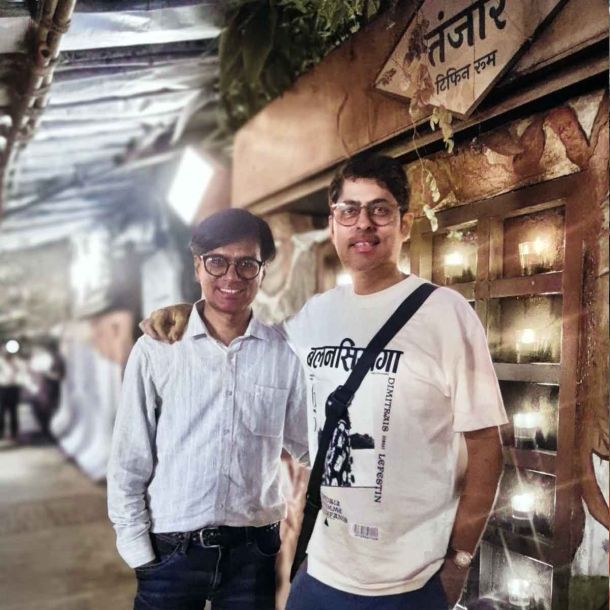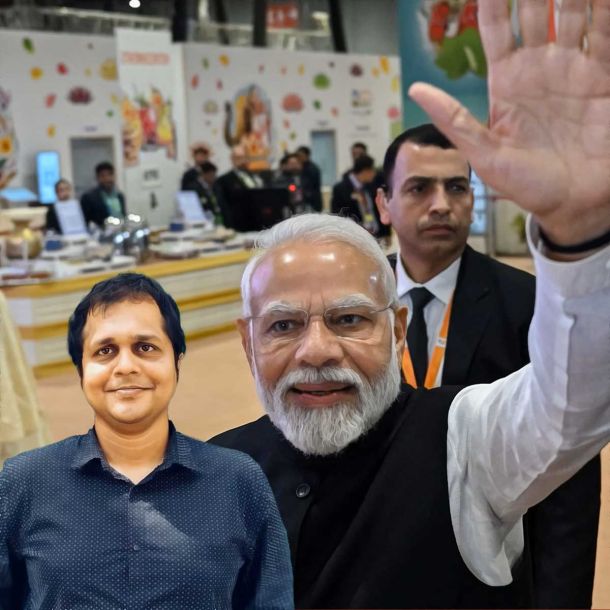More Coverage
Twitter Coverage
Satyaagrah
Written on
Satyaagrah
Written on
Satyaagrah
Written on
Satyaagrah
Written on
Satyaagrah
Written on
JOIN SATYAAGRAH SOCIAL MEDIA
"Sanatan Economy": Ayodhya's Ram Mandir to boost Uttar Pradesh's economy by Rs 4 lakh crore, says SBI Research, Niranjan Hiranandani sees real estate surge, as the city's GDP eyes monumental growth with Ayodhya attracting 5 crore visitors annually

In what is being described as a monumental boost to the economy of Uttar Pradesh, the upcoming opening of the Ram Temple in Ayodhya is projected to significantly elevate the state's financial prospects. According to a variety of national and international forecasts, the influx of visitors to Ayodhya, particularly after the temple's consecration ceremony, is anticipated to substantially benefit the state's economy.
A detailed analysis by SBI Research has brought to light some remarkable figures. The report claims that due to the influence of the Ram Temple, along with other tourism-driven initiatives, Uttar Pradesh could witness a substantial increase in its tax collections, potentially reaching as high as Rs 5,000 crore in the fiscal year 2024-25. This prediction underscores the significant economic impact the temple is expected to have.
Digging deeper into the report, it becomes evident that Ayodhya is not just a spiritual epicenter but also an economic powerhouse in the making. The study highlights Ayodhya as the primary catalyst in this economic upswing. With the surge in tourism spurred by the temple, the state's economy could be bolstered by approximately Rs 4 lakh crore this year alone. This figure is not just a testament to the temple's religious significance but also to its potential as a major economic driver.
In an international context, the impact of Ayodhya's Ram Temple is drawing parallels with some of the world's most renowned religious destinations. A report from the foreign stock market research firm Jefferies puts this into perspective. It states that Ayodhya is poised to surpass even Vatican City and Mecca in terms of visitor numbers. The projections are staggering – approximately 5 crore devotees annually, placing Ayodhya on the map as a major tourism hub, not just within Uttar Pradesh but across India.
To understand the magnitude of this, a comparison with other famous religious and tourist sites in India can be insightful. For instance, Tirupati Balaji in Andhra Pradesh, a significant pilgrimage site, attracts about 2.5 crore devotees each year, generating an annual revenue of Rs 1,200 crore. Vaishno Devi, another major pilgrimage destination, sees around 80 lakh visitors annually, contributing Rs 500 crore in revenue. In the realm of historical tourism, the Taj Mahal in Agra draws about 70 lakh visitors a year, creating a revenue of Rs 100 crore, while Agra Fort attracts 30 lakh visitors, contributing Rs 27.5 crore annually.
On the economic impact of Ayodhya's Ram Temple, it's insightful to look at international comparisons to grasp the full potential of this development. Mecca, one of the world's most significant religious sites, draws approximately 2 crore people each year, contributing a substantial $12 billion to Saudi Arabia's revenue. On the other hand, Vatican City, with its 90 lakh annual visitors, generates around USD 315 million. These figures illustrate the immense economic potential religious sites hold on a global scale.
In Ayodhya, the scenario is equally promising. A government official provided a striking estimate: on average, over one lakh devotees are expected to visit Ayodhya daily. This number could soon escalate to an astounding 3 lakh visitors per day. If each visitor spends about Rs 2,500 during their stay, the local economy of Ayodhya could see an addition of Rs 25,000 crore. This projection is not just a number; it represents a significant boost to the local economy, reflecting the temple's ability to transform the city into a major economic hub.
The economic benefits, however, extend beyond Ayodhya. The official highlighted a ripple effect across other religious sites in Uttar Pradesh. Devotees traveling to Ayodhya are likely to visit additional sacred places like the Kashi Vishwanath Temple in Varanasi and the Banke Bihari Temple in Mathura. This increased footfall is not just about spiritual journeys; it's a potential economic lifeline, positively impacting the local economies of these cities. The official estimated that this could add nearly Rs 1 lakh crore each year to UP's economy, significantly contributing to India's overall economic development.
A tourism department official further elaborated on the broader implications of this religious tourism boom. He pointed out that such a surge creates numerous opportunities for employment across various sectors, including transportation, hospitality, and the production of local goods. This isn't just about the tourism industry; it's about the holistic development of the local economy, benefiting a wide range of businesses and individuals.
Drawing parallels with countries like Switzerland, Italy, France, America, and the UAE, where tourism has been a cornerstone of economic development, the official expressed confidence in India's potential to join these ranks. With the inauguration of the Ram Temple in Ayodhya, India is poised to tap into this immense potential, harnessing the power of religious tourism to achieve unparalleled economic growth and development.
Ayodhya Ram Mandir Pran Pratishtha: 'Uttar Pradesh's GDP to Witness Bolstering Growth,' Says Niranjan Hiranandani
In a significant development highlighting the economic potential of Ayodhya's Ram Temple, Niranjan Hiranandani, the Founder and Managing Director of the Hiranandani Group, shared his perspectives on the temple's inauguration and its impact on the region's economy. In a LinkedIn post, Hiranandani stated, "with the inauguration of the Ram Temple on January 22, Ayodhya has the potential to attract more tourists." This observation reflects the anticipated increase in tourist inflow to Ayodhya, which is expected to boost local economic activities significantly.
The consecration of the Ram Mandir, a momentous occasion, was graced by the presence of Prime Minister Narendra Modi and various industry leaders and industrialists, including Hiranandani himself. This event not only marks a religious milestone but also signifies the commencement of a new economic era for the region.
Elaborating on the economic implications, Hiranandani stated in his post, "Ayodhya's historical significance and tourist potential make it an attractive investment. The operational Ram temple will attract more visitors, increasing the demand for residential and commercial properties." This statement underscores the direct correlation between Ayodhya's growing prominence as a religious and tourist destination and the consequent rise in demand for real estate in the area.
Hiranandani also focused on the broader economic opportunities arising from this development. He mentioned, "entrepreneurs and businesses have ample opportunities to meet the growing demand for goods and services." This comment points to the wide range of economic activities that are likely to flourish in response to the increased footfall in Ayodhya.
Highlighting the anticipated impact on the state's economy, Hiranandani further remarked, "Uttar Pradesh's GDP will report bolstering growth, given Ayodhya's cultural and emotional significance combined with the economic investment." This insight reflects his confidence in the positive and substantial influence that the development in Ayodhya will have on the overall economic growth of Uttar Pradesh.
While Niranjan Hiranandani expressed optimism about the region's economic potential, Gulam Zia, Senior Executive Director at Knight Frank India, offered a more nuanced perspective in an interview with Business Today TV.
Gulam Zia's comments shed light on the evolving landscape of religious tourism and its impact on investment opportunities. He stated, "Religious tourism as a concept is something which will see a sea change. This is one of the top destinations that is emerging globally and obviously that will give lots of opportunities to investors of all kinds-- commoners like you and I, to the big funds and sovereign authorities, etc. So, there are opportunities everywhere." This observation underscores the broad spectrum of investment potential in Ayodhya, ranging from individual investors to large financial institutions and sovereign funds.
Highlighting the scale of redevelopment in Ayodhya, Zia mentioned that "Rs 70,000 crore have been allocated for the redevelopment of Ayodhya and that tourism industry will grow apart from retail shops and gold souks." This significant financial commitment indicates a comprehensive plan to develop various sectors, including tourism, retail, and the gold market. Regarding real estate investments, Zia provided an estimate of the returns, saying, "guest houses should be looking at a rental return between 6 per cent to 9 per cent." He also noted the anticipated influx of tourists, mentioning, "I'm told that in the next month or so, we are expecting about three million tourists arriving in the city and these numbers are mindboggling."
However, Zia also cautioned investors about the current state of the real estate market in Ayodhya. He addressed concerns regarding the rapid escalation in land values, stating, "There are once again a lot of these estimates because most of these estimates are not supported by solid numbers or solid registration documents to assess it but then I'm told about 8-10 times increase has already happened in the values of land in and around Ayodhya." This surge in land prices, while indicative of the area's growing appeal, also poses a challenge for potential investors.
Further, Zia expressed reservations about the growth of commercial and office real estate in Ayodhya. He advised a cautious approach, suggesting that "investors should wait and watch until Ayodhya's masterplan is formed and the 1,200-acre Greenfield township worth Rs 2,180 crore as promised by the Uttar Pradesh government comes into place." This advice hints at the need for a more structured and informed investment strategy, taking into account the long-term development plans for Ayodhya.
 |
 Support Us
Support Us
Satyagraha was born from the heart of our land, with an undying aim to unveil the true essence of Bharat. It seeks to illuminate the hidden tales of our valiant freedom fighters and the rich chronicles that haven't yet sung their complete melody in the mainstream.
While platforms like NDTV and 'The Wire' effortlessly garner funds under the banner of safeguarding democracy, we at Satyagraha walk a different path. Our strength and resonance come from you. In this journey to weave a stronger Bharat, every little contribution amplifies our voice. Let's come together, contribute as you can, and champion the true spirit of our nation.
 |  |  |
| ICICI Bank of Satyaagrah | Razorpay Bank of Satyaagrah | PayPal Bank of Satyaagrah - For International Payments |
If all above doesn't work, then try the LINK below:
Please share the article on other platforms
DISCLAIMER: The author is solely responsible for the views expressed in this article. The author carries the responsibility for citing and/or licensing of images utilized within the text. The website also frequently uses non-commercial images for representational purposes only in line with the article. We are not responsible for the authenticity of such images. If some images have a copyright issue, we request the person/entity to contact us at This email address is being protected from spambots. You need JavaScript enabled to view it. and we will take the necessary actions to resolve the issue.
Related Articles
- "Spiritual Spark": Ayodhya's Ram Mandir heralds a new era, creating 20,000+ jobs in hospitality & travel, widespread impact felt in Lucknow, Kanpur, Gorakhpur, as sector leaders anticipate a surge in tourism, eagerly planning for an influx of devotees
- 'The Monk Who Transformed Uttar Pradesh and The Monk Who Became Chief Minister': Noted Author, Shantanu Gupta, who wrote bestsellers on Yogi Adityanath reached the USA for a multi-city book tour amid UP elections
- Semiconductor Titans, Micron, Applied Materials, and Lam forging robust alliances with India, unveiling monumental billion-dollar investments to significantly bolster India's Semiconductor Mission and usher a future of unprecedented tech advancements
- Ministry of External Affairs summons South Korea Ambassador over the pro-terror stance of Hyundai Pakistan on Kashmir and expressed strong displeasure of the Government: Korean Minister Yong exhibit regret
- “A leader is one who knows the way, goes the way, and shows the way”: Revolution underway in India's diamond industry as Nirmala Sitharaman’s focuses on lab-grown diamonds and set the proverbial cat among pigeons in the global diamond markets
- "Redefining doorstep delivery with a floating touch!": Amazon introduces its first ever revolutionary 'floating space' store on Dal Lake, Srinagar, enjoy seamless deliveries and empower local businesses with the 'I Have Space' initiative
- "In the market's good mood, fortunes are made and dreams are realized": Indian Tractor Sales soar to Unprecedented Heights by hitting all-time-high record of 9.44 lakh units in FY23, up 12% compared to last year, Brands achieve record-breaking figures
- A major boost to India’s defence system, the Philippines has accepted BrahMos Aerospace Pvt Ltd’s proposal worth USD 374.9 million: India’s proposal to supply Brahmos anti-ship Missile System gets green signal
- Clensta, a D2C Home Care Startup Raises Series A Funding
- PM Narendra Modi during his talk with US President Joe Biden offered to supply food stock to the world if the WTO agrees: Food stock in different parts of the world is dwindling due to the war (in Ukraine)
- Teary-eyed Sadhvi Rithambara and Uma Bharti's emotional embrace at Ram Mandir's Pran Pratishtha, Janakpur's 125,000 Diyas celebration, PM Modi honoring the shramiks, and Arun Yogiraj's revered Shri Ram idol creation, culminate in a historic, divine event
- “Only those who risk going too far can possibly find out how far one can go”: 7 Adani airports saw an increase of 92% in domestic, 133% in international travelers, handled record 14.25 million passengers last year & stocks gained ₹2.2 lakh crore in 6 days
- Hyundai celebrating ‘Kashmir Solidarity Day’ had been facing nationwide boycott calls in India: Issues second statement that post by Pakistani counterpart unauthorised, expresses ‘regret’ for pro-terrorist stand
- "In unity there is strength; in partnership, there's power": India-UAE economic alliance marks turning point in their shared history, CEPA to boost trade, stimulate investments & fortify economies, advancing both nations towards mutual growth & prosperity
- "नई उड़ान": Bharatiya Vayuyan Vidheyak, 2024, replaces the Aircraft Act, 1934, modernizes aviation laws, empowers DGCA, BCAS, AAIB, adds penalties, regulates design, and Aviation Minister K Naidu schools INDI Alliance for opposing the Hindi name




























